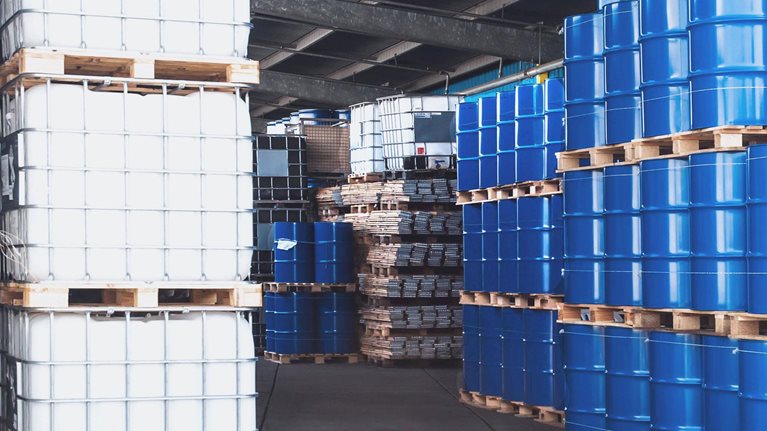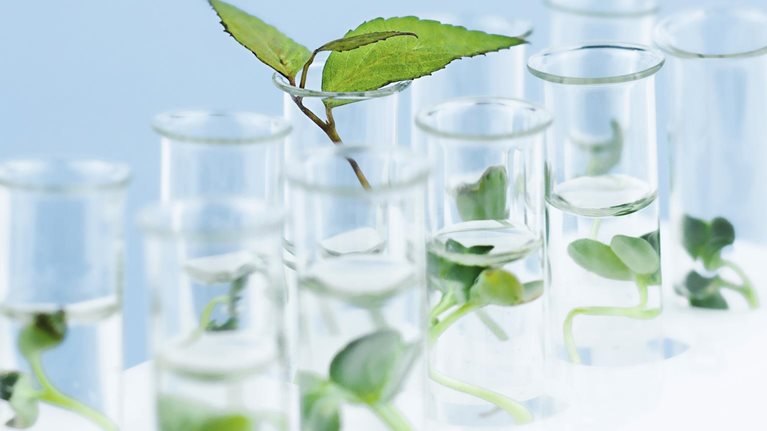Since 2010, the chemical industry has shown strong overall performance, with the TSR of global commodity and specialty chemical companies increasing four to seven times over. Similarly, Japanese chemical companies’ performance has historically been strong, including leadership in various global segments.
Our research shows that Japanese chemical companies can further this success by capitalizing on proven strengths and deep industry knowledge. This article reviews the current landscape of chemical companies in Japan and highlights three themes and specific actions leaders can take to regain momentum in the industry: strengthening their specialty product portfolio, upgrading their operating model, and adapting to global markets.
Chemicals in Japan: Market analysis
Despite Japanese chemical companies’ strong historical performance, their TSR grew by 7.5 percent each year from 2018 to 2021, in contrast to 25.8 percent growth in global specialties (Exhibit 1). And although resilient global chemical companies produced strong results during the COVID-19 crises (11.4 percent CAGR in revenue since 2019), Japanese chemical companies have struggled (1.8 percent), showing lower TSR performance compared with nonresilient global chemical companies (4.9 percent).

The recent TSR performance of Japanese chemical companies has largely been driven by plateaued ROIC and revenue growth. In fact, the Japanese chemical industry has shown a negative revenue CAGR of 0.32 percent over the past ten years, which is 3.9 percent below the global chemical industry and 2.3 percent below the global specialty chemical industry.
In the same period, Japanese chemical companies generated ROIC of 8.8 percent, falling short of the 17.7 percent generated by global specialties players.1 This number was driven by the following three metrics, in which Japanese chemical companies consistently lagged behind global specialties2: lower EBITA margins (7.9 percent in Japan versus 11.9 percent for global specialties players on average over this period); lower capital-efficiency ratio (1.6 in Japan versus 2.0 for global specialties players); and higher percentage of cost of goods sold (69.6 percent for Japanese companies versus 65.5 percent for global specialties players).
All that said, despite the relative slowness of the past few years, the Japanese chemical industry has made material improvements since 2010–13. Thus, careful analysis of what industry leaders have gotten right can help inform actions to take in the years to come.
Building on strong historical performance to ensure long-term success
Japanese chemical companies can build on their strong historical performance and ensure long-term success by taking three actions: strengthening their specialty product portfolio, upgrading their operating model, and adapting to global markets.
Strengthen the specialty product portfolio and shift to a market-back approach
This entails splitting specialty chemical business units from commodities, reallocating resources to high-growth industries, and investing in customer-centric R&D.
Split specialty chemical business units from commodities to accelerate the shift to a market-back approach and the offering of customer-oriented solutions. Our research shows that as of 2021, four Japanese companies are among the top 20 specialty chemical companies in market share. More Japanese companies can follow this trend by reconfiguring their portfolios to focus on specialties; global chemical companies often offer customer-tailored solutions and sophisticated, jointly created solutions specific to customer needs. Based on 2019 revenue, the top 20 chemical players focus 70 percent of their revenue in specialties, while the number for Japanese players is 47 percent.
Roughly half of Japanese chemical companies have yet to configure a market-driven portfolio, and some low-margin products are affecting profits. On this point, many Japanese companies produce a large share of petrochemicals, such as polyethylene and polypropylene, both of which are sourced from relatively expensive feedstocks (considering Japan has older, more expensive assets), leaving pressure on margins.
To maintain margins and effectively shift to specialties, companies can manage the specialty business separately from commodities. Typically, both are run by the same leadership teams and consequently retain the same KPIs and decision structures. However, the strategies for cost allocation should be different. In the commodity business, high turnover and optimized operations in cost of goods sold and selling, general, and administrative (SG&A) expenses, including R&D, are required to earn sufficient profit due to small margins. In the specialty segment, however, expenditures on application development, marketing, and sales are necessary to develop products tailored to customer needs. With these differences in mind, Japanese companies can redesign their organizations to prioritize and capture opportunities in each segment.
Make bold choices to reallocate resources to high-growth and less cyclical industries. Japanese chemical players have been and still are market leaders in certain segments, with more than 50 percent of global market share in areas such as polarizers. However, market share in the former has dropped by 2.4 percent CAGR in the past ten years and settled at 45.2 percent, while market share in the latter has dropped by 1.5 percent CAGR and settled at 44.1 percent (Exhibit 2). Although both values are still relatively high, demonstrating Japan’s overall competitive strength, the drop illustrates the emergence of new entrants gaining share in niche markets.

Moreover, exports to destinations such as China and Korea declined in value by 2 and 21 percent, respectively, from 2018 to 2020. And the trade conflict between China and South Korea has created demand headwinds, increasing self-sufficiency and free-trade agreements between China and ASEAN as well as competition with Southeast Asian countries.
To maintain a strong position in the current landscape, Japanese companies can cultivate new markets through business-model and customer-experience innovation, which has become an increasingly important shift in the industry. That said, innovative solutions require a comprehensive approach and clearly established priorities. Japanese chemical companies could therefore restructure their product portfolios to shift to areas of high growth and less cyclical end-use industries, such as automotive and electronics, which largely consume specialty chemicals, such as catalysts and specialty polymers. To better promote these products, marketing will also be key. Japanese chemical companies currently spend less on marketing expenses (3.5 percent of revenue) than global specialties (5.8 percent) or global commodities companies (3.9 percent).3 To optimize marketing spending, building cross-functional teams involving members of other departments, such as R&D and analytics, as well as experts with knowledge of the downstream market, can strengthen the marketing strategy. More recently, applying digital approaches has helped companies tap new opportunities and improve return on sales performance.
Drive customer-centric R&D activities that create innovative and tailored solutions. To drive innovation, Japanese companies have continued to invest in R&D, spending 3.5 percent of revenue in 2021, a higher proportion than the 1.0 percent by companies in South Korea, 1.3 percent in Taiwan, 2.4 percent among international diversified, and 3.9 percent for international specialties players. In absolute terms, Japanese companies have increased R&D spending over the past decade; however, patent applications have decreased 1.2 percent during this time.
To better capitalize on their R&D expenditure, companies can switch from a product push to a market-back approach, which emphasizes continuous adaptation. One example is a multinational chemical company that leads in patent filings (per $100 million spent). The company’s R&D spend relative to sales is 2.8 percent, one of the lowest proportions among global peers. Despite the company’s lower spending on R&D, its strong R&D capabilities derive from its customer focus and global innovation networks and from partnering with its 100,000 customers globally in nearly all sectors to provide innovative and tailored solutions.
Improve ROIC by upgrading the operating model to sustain new levels of globalization, speed, agility, and efficiency
This entails treating international M&A as a means of upgrading the operating model, acquiring new digital capabilities, and building a resilient supply chain.
Treat international M&A not as a volume play but as a strategy to upgrade the operating model. Although M&A remains a critical approach for Japanese chemical companies to expand globally, many have struggled to reap the benefits. In fact, M&A in Japanese chemicals have grown by 35 percent annually within the past ten years, yet these activities generated 37 percent less excess TSR and 1 percent less revenue growth from year one to year three compared with global M&A.4 That said, one global specialties company expanded its high-performance materials division three years after the acquisition and ultimately achieved 9 percent revenue growth and 78 percent excess TSR.
To fully leverage global M&A, Japanese companies can better optimize their operating models to adapt to customs and demand overseas. As an example, in 2021, the cash-conversion cycle for Japanese chemical companies was 22 percent longer than the cycle for global specialties players. This is largely the result of longer days of receivables outstanding, which is 38 percent longer in Japanese chemicals, a sign that companies are still applying a Japanese-centric model overseas.
Moreover, Japanese companies can pursue programmatic M&A, a strategy of conducting a series of deals around a central business strategy, often a bold strategic move such as a portfolio shift or building new businesses. Programmatic M&A is more likely to lead to sustainable growth than a “big bang” volume play is. As an example, a Japanese chemical company that successfully leveraged M&A and effectively expanded its geographical presence to Asia, the European Union, and the United States increased its revenue TSR by more than 700 percent in just a few years.
Acquire digital capabilities and redesign roles to boost operational efficiency. Japanese companies can accelerate the digitalization of marketing and SG&A functions, such as customer platforms, dynamic pricing, and sales-force automation. Doing so will likely boost productivity; Japanese chemical companies currently generate 21 percent less revenue per employee than global specialties players and 34 percent less than the global industry average, despite spending a similar proportion of revenue, 14 to 15 percent, on SG&A (Exhibit 3).

An end-to-end digital transformation can unlock significant savings. One example is analytics-assisted formulation development in innovation, with an impact of 0.5 to 1.0 percent EBITDA improvement potential, an 8 percent return on sales (ROS) improvement at specialty chemical business units, and a 10 to 20 percent increase in service level or sales enablement. Digital transformation will radically change the way people work, especially in Japanese companies that have higher levels of administrative work with a stronger preference for paper documents and seal of approval. Optimizing processes will enable companies to allocate more resources to sales activities and other customer-facing roles.
Several leading Japanese chemical companies have begun to recognize the potential of digitalization through improving plant operation systems and effectively managing R&D activities with support from newly placed digital specialists.
Build a lower-cost, resilient supply chain to ensure margin protection. As chemical companies face disruptions that are likely to persist, such as geopolitical and supply chain uncertainty, it can help to reassess the costs and sustainability of the supply chain.
One current reason for the lower ROIC of Japanese chemical companies is their operations in high-cost locations. According to our analysis, the share of Japanese players that manufacture goods in high-cost locations is 29 percent higher than for global players in the same segments. As an example, the manufacturing sites for one of the top European auto glass producers are found in lower-cost locations, whereas Japanese players in the same segment account for more than half of the sites located in higher-cost countries.
In addition to continuously optimizing locations, renegotiating contracts and reassessing pricing strategies are also examples of strategic moves to retain profitability and growth.
Adapt to global markets by changing the mindset and culture and improving diversity
This entails relocating business units closer to customers, adopting English as a corporate language, and improving diversity.
Relocate business units or corporate headquarters closer to customers. As previously mentioned, establishing a global operating model is key to success for Japanese companies. They must change their mindset to actively engage with global markets. When building global operating models, leading companies have relocated their business hubs, such as headquarters, business units, and R&D sites, closer to their international customers. In addition, 52 percent of global specialty chemical demand is located in the Americas and Europe, with the remaining 48 percent in Asia. Within Asia, 52 percent of the demand is based in China, with an expected CAGR of 5.8 percent from 2018 to 2023.
To capture opportunities abroad, companies must be willing to relocate closer to their customers and partners to capture value efficiently. This holds true for customer care and employee management as well, to avoid providing products that go beyond customer expectations or unsuitable customer service offerings, often granted free of charge.
Adopt English as a corporate language. To effectively manage the global operating model, deconstructing the language barrier can be a good starting point. A common language will improve the efficiency of global operations. On this point, Japanese chemical companies can accelerate rates of English adoption, which have been stagnant over the past decade. In our discussions, industry experts noted that most Japanese chemical companies are behind the standard level in English adoption.
Improve diversity in management and on boards of directors, focusing on non-Japanese members and women. Japanese companies have recently exhibited some improvement in gender diversity and incorporating foreign nationals, but it has not been enough to catch up with global peers. From our analysis, on average, board members at Japan’s top ten chemical companies are only 10 percent women and 1 percent foreign nationals.
Japanese companies are encouraged to continue their efforts, as data show that higher return on assets (ROA) can be realized from improving diversity in leadership positions. For example, on average, 2.5 percent higher ROA can be realized if more than one woman serves in a leadership position, such as manager, director, officer, or executive officer. Further, 2 percent higher ROA on average is possible if more than one foreign national assumes one of these roles.
Japanese chemical companies have the opportunity to build on their strong foundations—and successes of the past—by shifting their focus in the years to come. As this article illustrates, leaders can embrace a truly global operating model by pursuing growth in specialty chemical segments. Doing so could mean the difference between increasing success or falling further behind.


